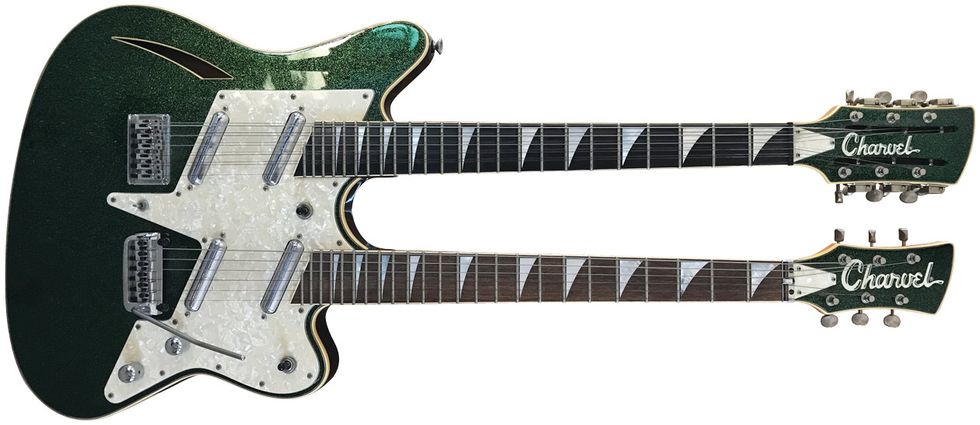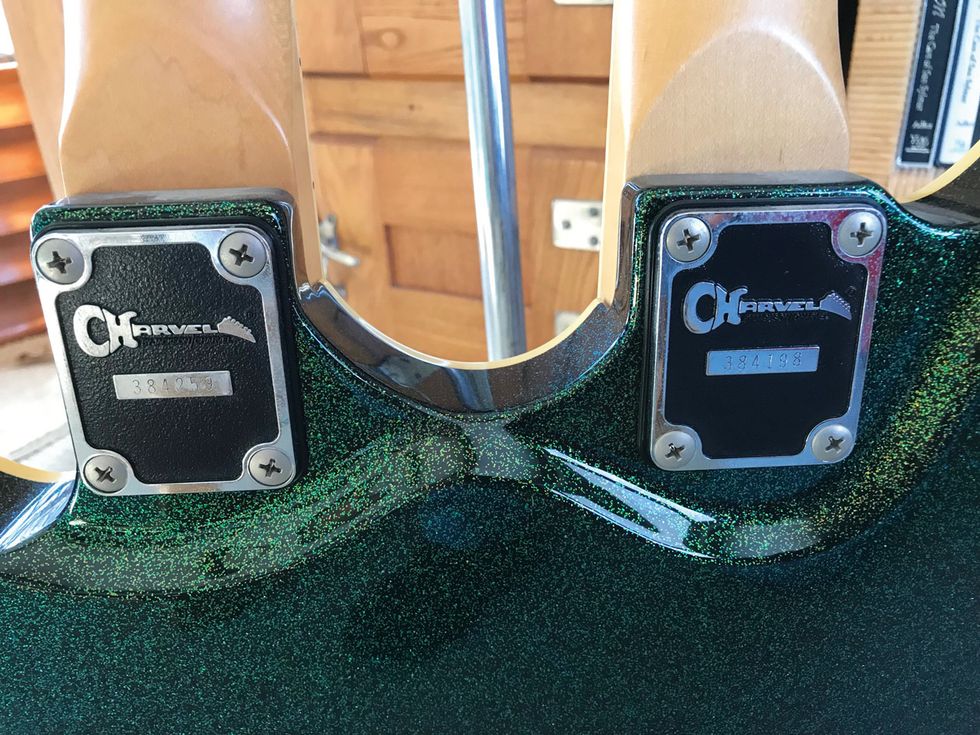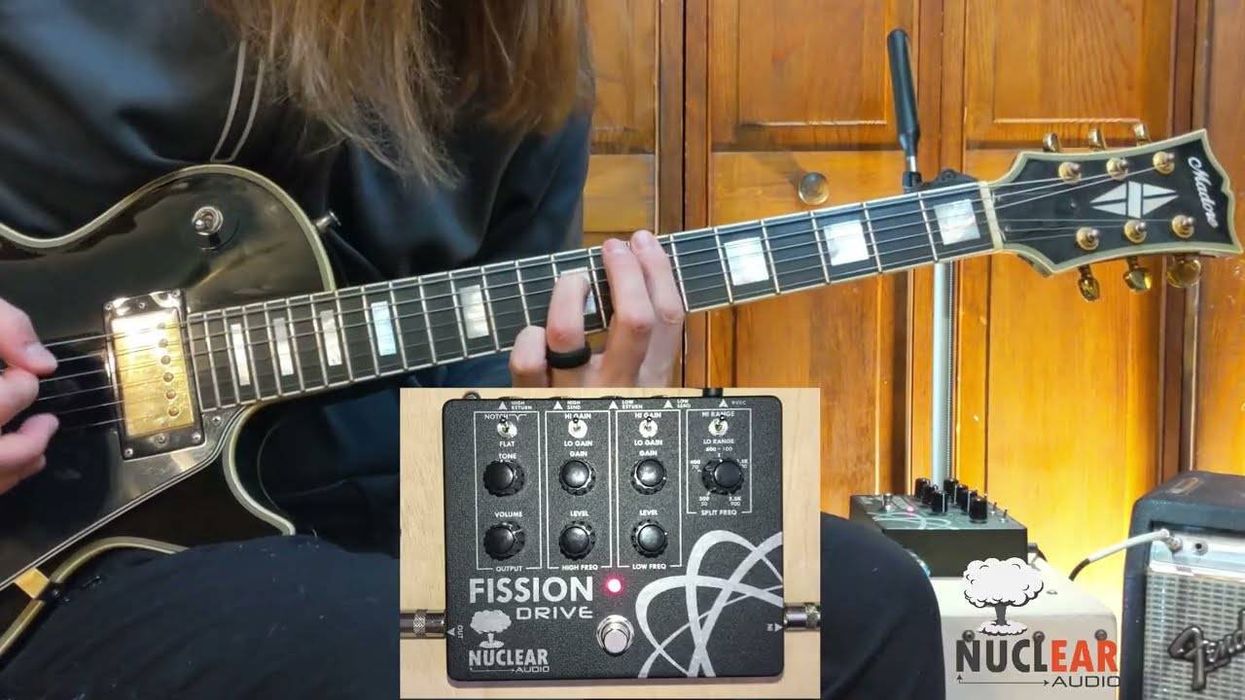Hi Zach,
I bought this cool Charvel Surfcaster doubleneck about 15 years ago at the Dallas Guitar Show for $2K. The dealer said he thought it was one of maybe only three or four made, but I can’t seem to find out much about it. What do you think it’s worth now?
Peter in Mesa, Arizona
Hey Peter,
This is a rare bird on many levels. First of all, Charvel is generally known for their “pointy” guitars used by metalheads in the 1980s and 1990s, whereas this guitar’s ’50s-style body is a complete 180 from what Charvel typically produced. Second, it’s a doubleneck that very well could be one of just a handful made. And last, it has a green-pearloid finish that appears to be unique to just the Surfcaster doubleneck. Let’s talk some history.
Charvel was founded in the ’70s by Wayne Charvel, who had worked at Fender for three years in the early part of the decade before starting his own shop called Charvel’s Guitar Repair in Azusa, California. Charvel quickly earned a reputation for quality repair work and upgrading guitars with aftermarket parts. Grover Jackson started working at Charvel’s shop in 1977 and bought Wayne out in 1978 (essentially ending Wayne’s association with the company). Jackson then introduced the first Charvel custom guitars at the 1979 NAMM show.
The early Charvel guitars were of the Strat-style, pointy variety, which quickly became popular with guitarists such as Eddie Van Halen, Richie Sambora, and Warren DeMartini. Jackson’s own trademark took off in the early 1980s when he produced a radically shaped version of the Flying V for Randy Rhoads, thus establishing two separate brands in Charvel and Jackson that have been forever linked. In the later 1980s, Jackson licensed his designs to International Music Corporation (IMC) and later sold both trademarks to them. In 1986, IMC began producing Charvel instruments exclusively in Japan.
So, how does the Surfcaster fit into all of this? I’m not sure anyone knows exactly why the Surfcaster was developed, but in the late 1980s, Fender and other manufacturers were just scratching the surface of making reissues of their famous models from the 1950s and 1960s. Because Charvel had only existed since the early 1970s, we can assume they came up with their own new/retro design to join in on the reissue craze, which ultimately became the Surfcaster. Steve Cropper was an endorser of the original model.
The Surfcaster is instantly recognizable, with its hourglass-style body and a shortened treble horn, single “cat’s-eye” bound soundhole, lipstick pickups, and pearloid pickguard. True to its name, the Surfcaster pays homage to the surf-music fad of the 1960s, and these guitars are known for their twangy sound thanks to single-coils and hollow bodies. Early Surfcaster prototypes appeared in 1990 and full-production models started arriving a year later. Specifications included a basswood body (with optional figured-maple top), a bolt-on maple neck, a 24-fret bound-rosewood fretboard with shark-fin inlays, a matching-finish headstock, two lipstick single-coils, and a vibrato bridge. A humbucker-equipped model, 12-string version, and even a bass version were also offered.
Interestingly, this vintage and rare doubleneck has a pair of different serial numbers to go along with its 6-string
and 12-string necks.
The doubleneck was another variation, but offered in very limited quantities in 1992 and 1993. It features a traditional doubleneck design with a 12-string on the left (upper side) and a 6-string on the right (lower side). Note that this guitar has two serial numbers, since they engraved one on every neck plate for all instruments, which definitely makes for some interesting record keeping! In terms of value, one of these recently sold for about $1,800, and I think that’s right around what your doubleneck is worth today: between $1,700 and $2,000. For comparison, regular 6-string Surfcasters are valued between $1,100 and $1,400. It hasn’t appreciated as much as you likely hoped, but you can rest easy knowing you have one of only a few of these rare birds.
Charvel produced the first run of Surfcasters until the mid-1990s, when the brand was largely ignored until Fender bought the trademark in 2002. (The second run of Surfcasters were produced under the Jackson trademark, circa 1998 until 2001.) Under Fender’s ownership, a third run of Surfcasters was introduced, but they were starkly different from the first two editions and were made in India, which resulted in a drop in quality. (They also produced a model called the Skatecaster that utilized the same body shape, but was essentially a different guitar.) Over the years, there have also been efforts to revive the Surfcaster by other companies, including the late Ed Roman and Eastwood Guitars.
So, the Surfcaster basically represents Charvel’s reissue of a guitar that never existed. When you consider how rare the doubleneck model is, it’s pretty easy to classify your guitar as a treasure.












![Rig Rundown: Russian Circles’ Mike Sullivan [2025]](https://www.premierguitar.com/media-library/youtube.jpg?id=62303631&width=1245&height=700&quality=70&coordinates=0%2C0%2C0%2C0)






